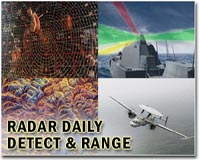 |
Washington DC (SPX) Nov 12, 2010 Using a neutron beam as a probe, researchers working at the National Institute of Standards and Technology (NIST) have begun to reveal the crystal structure of a compound essential to technologies ranging from sonar to computer memory. Their recent work provides long-sought insight into just how a widely used material of modern technology actually works. The compound is a "piezoelectric," a material capable of changing one kind of energy into another-mechanical to electrical, or vice versa. Long employed in sonar systems to detect sound waves, more recently piezoelectrics have been applied in devices that require minuscule changes in position, such as the head that reads data from your computer's hard drive. For decades, the industry standard piezoelectric has been PZT, a compound that contains titanium,zirconium, lead and oxygen. Crystals of PZT change a tiny fraction of a percent in size when a sound wave strikes them, and thisshape change creates an electrical impulse. Decades ago, it was discovered that PZT performs at its best when the titanium and zirconium appear in approximately equal proportions, but no one really understood why. "The theories frequently concern what happens at the transition line between having a surplus of zirconium and one of titanium," says Peter Gehring of the NIST Center for Neutron Research (NCNR). "Some theories suggest that right near the transition zone, the atoms take on a special configuration that allows certain atoms to move more freely than they can otherwise. But because it's been hard to grow a crystal of PZT large enough to analyze, we couldn't completely test these ideas." A breakthrough came when chemists at Canada's Simon Fraser University managed to grow single crystals of a few millimeters in size and sent them to the NCNR for examination with neutron scattering-a technique for determining the positions of individual atoms in a complex crystal structure by observing the patterns made by neutrons bouncing off it. The team, which also included researchers from the University of Oxford, the University of Tokyo, and the University of Warwick, was able to definitively rule out one of the proposed structures of PZT. Instead, they found that each PZT crystal element likely assumes one of two possible forms that coexist within the larger crystal array. These forms are dictated by chemical composition, and they may influence how well the material performs on a large scale. Their findings also suggest that the change in behavior seen at the transition happens gradually, rather than at some sharply delineated proportion of zirconium to titanium. Gehring says the results could be a step toward bettering PZT. "Determining the structure might give us the perspective necessary to design a piezoelectric material from first principles, instead of just playing around and seeing what works," he says. "That's what you need if you're ever going to build a better mousetrap." D. Phelan, X. Long, Y. Xie, Z.-G. Ye, A.M. Glazer, H. Yokota, P.A. Thomas and P.M. Gehring. Single crystal study of competing rhombohedral and monoclinic order in lead zirconate titanate. Physical Review Letters, Nov. 8, 2010, DOI: 10.1103/PhysRevLett.105.207601
Share This Article With Planet Earth
Related Links National Institute of Standards and Technology (NIST) Space Technology News - Applications and Research
 Raytheon Multi-Spectral Targeting Delivers High-Definition
Raytheon Multi-Spectral Targeting Delivers High-DefinitionMcKinney TX (SPX) Oct 29, 2010 Raytheon is upgrading sensors with enhanced target location accuracy and high-definition imaging. "This is an important upgrade for our Multi-Spectral Targeting Systems family of sensors as we continue to provide high-performance, state-of-the-art technology for the warfighter," said Tim Carey, vice president for Intelligence, Surveillance and Reconnaissance Systems. "Target location accur ... read more |
|
| The content herein, unless otherwise known to be public domain, are Copyright 1995-2010 - SpaceDaily. AFP and UPI Wire Stories are copyright Agence France-Presse and United Press International. ESA Portal Reports are copyright European Space Agency. All NASA sourced material is public domain. Additional copyrights may apply in whole or part to other bona fide parties. Advertising does not imply endorsement,agreement or approval of any opinions, statements or information provided by SpaceDaily on any Web page published or hosted by SpaceDaily. Privacy Statement |